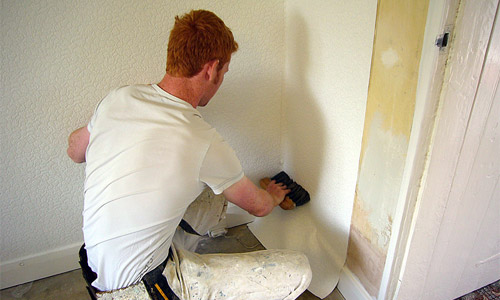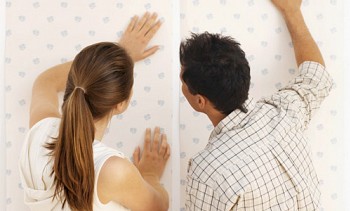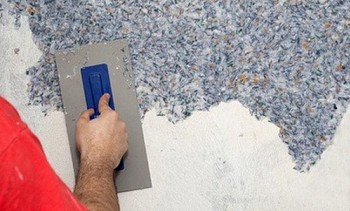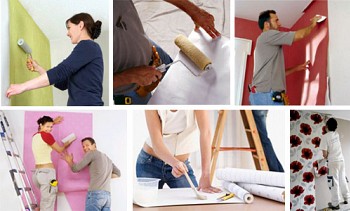The most common way of decorating walls in rooms is wallpapering. At first glance, the technology of the process itself is quite simple - apply glue to a strip of wallpaper and stick it to the wall. That is why the owners of apartments and houses decide to independently carry out this type of finishing work.

Content:
If the wall section is smooth, prepared correctly and does not have obvious defects in the form of bulges and depressions, then someone who is far from such work can really stick wallpaper. But how to glue the wallpaper in the corners and at the same time observe the coincidence of the picture? In such cases, a certain technique should be used, without which it will be difficult to achieve the desired result.
Possible problems and nuances when pasting corners with wallpaper
Ideally, in order not to cut the strip at the bend, the corners of the room should be strictly vertical and straight. Then the process of wallpapering would be reduced to one continuous operation, which consists in processing the wall and canvas wallpaper, followed by gluing. But, unfortunately, there are practically no rooms with absolutely correct geometric parameters, at least one corner will turn out to be crooked.
As a result, the first glued wall will still be vertical, and as you move from wall to wall, there will be a skew increasing from one canvas to another. The pattern will shift to the corners and will be uneven with respect to the horizontal surfaces of the floor and ceiling.
Another point that must be taken into account when conducting this type of work is what material the wallpaper is made of, individual characteristics leave an imprint on the whole process.
Wallpaper made of paper cloth without additional layers, the most capricious. In this case, the work should be carried out quite quickly, the paper quickly absorbs the water contained in the glue. It is necessary to overexpose the treated strip a little, as it begins to creep into pieces.
After coating, the vinyl-coated wallpaper should be given a little time so that it is better saturated. But some types of these wallpapers have a very gentle spraying of the pattern and they can be pressed to the surface only using rubber rollers. In corners, it is especially important to ensure the best adhesion of the canvas to the wall. The use of rags can adversely affect the picture.
Non-woven wallpaper does not require glue processing on their back side. It is enough to smear only the surface of the wall, and in the corners once again additionally go through the adhesive solution before work.
The denser the material, the smaller the overlap should be, and in the case of cullet strips, the strips should be glued butt - even the smallest overlap will be very noticeable in the corners.
How to glue wallpaper on the inner corners
The main task when pasting wallpapers is to ensure that “wrinkles” do not form in the corners, and at the same time the stripes of wallpaper do not diverge downward. consider to what extent the angle is curved, the greater the curvature, the greater the allowance should be.
The edge should be pressed as hard as possible to the wall. If at the same time the strip begins to “wrinkle”, then with scissors it will be necessary to make small notches, cutting the sheet in the direction of the “wrinkle”.
The next stage is the marking, which will be the imposition of a new strip of wallpaper on an adjacent wall. To do this, from the inlet of the first canvas launched onto this wall, it is necessary to postpone a distance equal to the width of the wallpaper to be glued and reduced by 5 mm. Then, using the level in this place, you need to draw a vertical line.After the end of the marking, we paste the second sheet, and in order for it to be oriented strictly vertically along the drawn line.
How to glue wallpaper on external corners
To do this, get ahead of the point from which the sheet will go so that it bends around an angle to a width of 30 mm. The edge of the wallpaper needs to be pressed firmly against the wall, and if wrinkles appear on it, just like in the case of the internal corners, make cuts, only here they should be small. Along the edge of the wallpaper, which is bent to the next wall, tear off a narrow strip of wallpaper so that only a small edge remains. Such a technique will help to make the seam as thin as possible, and the overlap will not be so noticeable.
Then, using a level, beat off from the corner a distance equal to the width of the wallpaper and increased by 6mm.
Glue a new sheet along this border. In this case, the edge of the new sheet should overlap the edge wound on the wall from the adjacent sheet.
Press down the joints with effort, smooth the top and bottom of the wallpaper with a trim, and only then go through the edges with a rubber roller.
Video: How to paste and crop wallpaper in the corners




